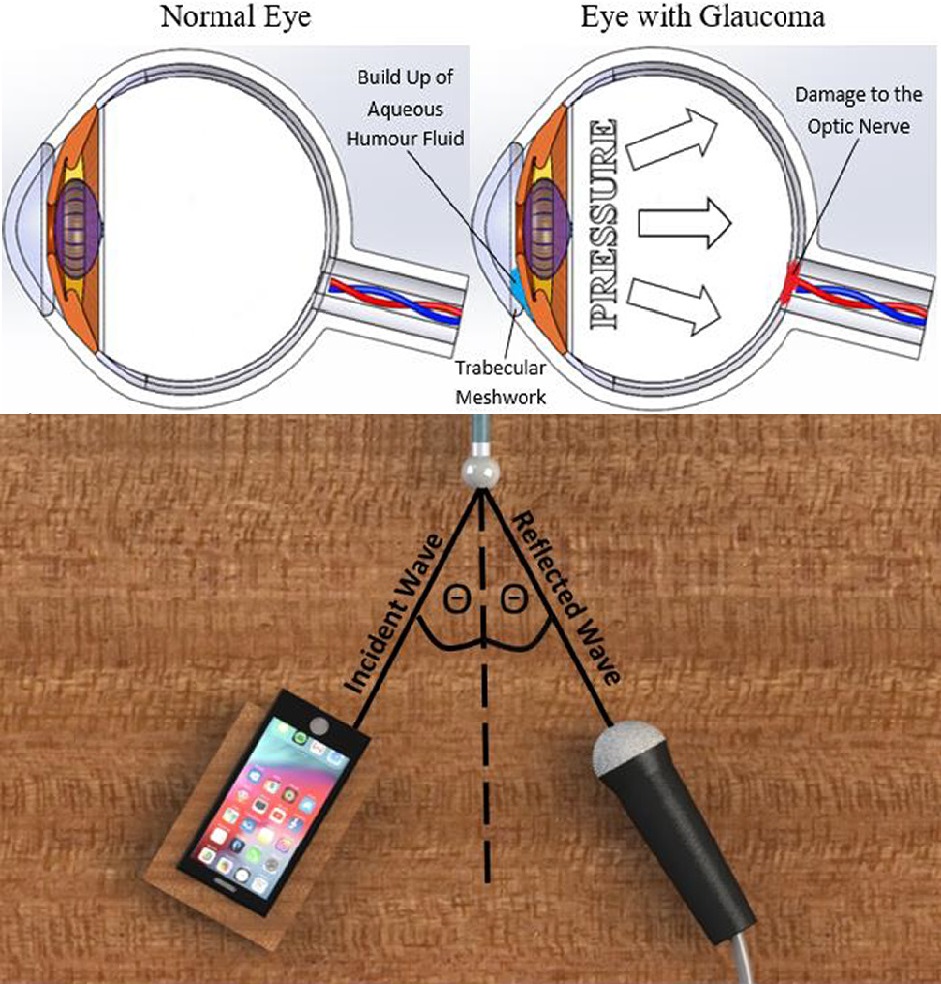

The human eye is a very sensitive and cherished organ for its unparalleled use for humans on a daily basis. Thus, its continued state of health is of upmost importance to individuals worldwide. Some of the most common eye related diseases – Glaucoma are often avoidable and display strong risk factors some time before their onset.
For example, in the case of diabetic retinopathy, individuals with diabetes are specifically at risk and so are constantly monitored for background retinopathy, tiny bulges that develop in the blood vessels of the eye.
However, in the case of glaucoma, an ocular disease with age and elevated levels of intraocular pressure (IOP) as significant risk factors, it is harder to specify such a specific group of individuals at risk of development.
For this reason, an accurate, non‐invasive, mobile measurement of IOP would provide a means to continuously monitor an individual’s IOP over an extended period. This would lead to earlier diagnosis and treatment of the condition, drastically increasing the chances of maintaining the individual’s vision.
Intraocular pressure (IOP)
Early detection of increasing values of intraocular pressure (IOP) due to glaucoma can prevent severe ocular diseases and ultimately, prevent loss of vision. Currently, the need for an accurate, mobile measurement of IOP that shows no correlation to central corneal thickness is unmet within the modern healthcare practices. There is a potential to utilize soundwaves as a mobile measurement method.
However, according to the study experiment showing comprehensively that there is a relationship between the internal pressure of an object and its acoustic reflection coefficient, providing a confirmation of the theory that would allow mobile measurements of IOP to be conducted with the use of a smart phone.
Smartphones could be used to scan people’s eyes for early-warning signs of glaucoma – helping to prevent severe ocular diseases and blindness, a new study reveals.
Some of the most common eye-related diseases are avoidable and display strong risk factors before onset, but it is much harder to pinpoint a group of people at risk from glaucoma.
Glaucoma is associated with elevated levels of intraocular pressure (IOP) and an accurate, non-invasive way of monitoring an individual’s IOP over an extended period would help to significantly increase their chances of maintaining their vision.
Soundwaves used as a mobile measurement method would detect increasing values of IOP, prompting early diagnosis and treatment.
Scientists have successfully carried out experiments using soundwaves and an eye model, publishing their findings in Engineering Reports.
Co-author Dr. Khamis Essa, Director of the Advanced Manufacturing Group at the University of Birmingham, commented: “We discovered a relationship between the internal pressure of an object and its acoustic reflection coefficient.
With further investigation into eye geometry and how this affects the interaction with soundwaves, it is possible to use a smartphone to accurately measure IOP from the comfort of the user’s home.”
Risk factors for other eye diseases are easier to assess – for example, in the case of diabetic retinopathy, individuals with diabetes are specifically at risk and are constantly monitored for tiny bulges that develop in the blood vessels of the eye.
The current ‘gold standard’ method of measuring IOP is applanation tonometry, where numbing drops followed by non-toxic dye are applied to the patient’s eyes. There are problems and measurement errors associated with this method.
Risk factors of Glaucoma
An independent risk factor of glaucoma is having a thin central corneal thickness (CCT) – either by natural occurrence or a common procedure like laser eye surgery.
A thin CCT causes artificially low readings of IOP when using applanation tonometry. The only way to verify the reading is by a full eye examination – not possible in a mobile situation. Also, the equipment is too expensive for most people to purchase for long-term home monitoring.
IOP is a vital measurement of healthy vision, defined as pressure created by continued renewal of eye fluids. Ocular hypertension is caused by an imbalance in production and drainage of aqueous fluid – most common in older adults. Risk increases with age, in turn increasing the likelihood of an individual developing glaucoma.
Glaucoma is a disease of the optic nerve which is estimated to affect 79.6 million people world-wide and, if left untreated, causes irreversible damage. In most cases, blindness can be prevented with appropriate control and treatment.
more recommended stories
 Spatial Computing Explains How Brain Organizes Cognition
Spatial Computing Explains How Brain Organizes CognitionKey Takeaways (Quick Summary) MIT researchers.
 Gestational Diabetes Risk Identified by Blood Metabolites
Gestational Diabetes Risk Identified by Blood MetabolitesKey Takeaways (Quick Summary for Clinicians).
 Phage Therapy Study Reveals RNA-Based Infection Control
Phage Therapy Study Reveals RNA-Based Infection ControlKey Takeaways (Quick Summary) Researchers uncovered.
 Pelvic Floor Disorders: Treatable Yet Often Ignored
Pelvic Floor Disorders: Treatable Yet Often IgnoredKey Takeaways (Quick Summary) Pelvic floor.
 Urine-Based microRNA Aging Clock Predicts Biological Age
Urine-Based microRNA Aging Clock Predicts Biological AgeKey Takeaways (Quick Summary) Researchers developed.
 Circadian Control of Neutrophils in Myocardial Infarction
Circadian Control of Neutrophils in Myocardial InfarctionKey Takeaways for HCPs Neutrophil activity.
 E-Cigarette Use and Heart Attack Risk in Former Smokers
E-Cigarette Use and Heart Attack Risk in Former SmokersKey Takeaways for Clinicians and Nurses.
 36-Week Pre-eclampsia Screening May Reduce Term Risk
36-Week Pre-eclampsia Screening May Reduce Term RiskA New Preventive Strategy for Term.
 Cardiovascular Risk and Sudden Cardiac Death in Diabetes
Cardiovascular Risk and Sudden Cardiac Death in DiabetesRising Sudden Cardiac Death (SCD) Risk.
 Poor Kidney Function and Alzheimer’s Biomarkers Explained
Poor Kidney Function and Alzheimer’s Biomarkers ExplainedPoor kidney function may influence levels.

Leave a Comment